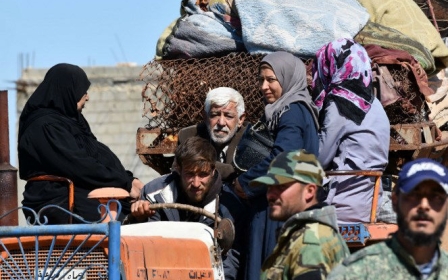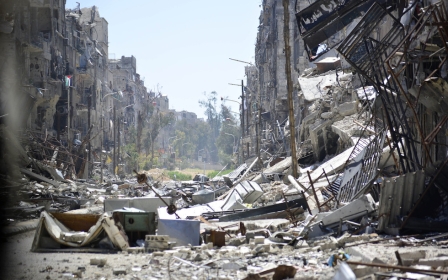Thousands of civilians trapped as Syrian army bombards Yarmouk
Thousands of civilians remain trapped in Yarmouk, as fighting intensifies between the Syrian government and militants with the Palestinian refugee camp.
“We estimate that there were about 6,000 Palestine refugee civilians in Yarmouk and about 6,000 in the surrounding areas,” said Chris Gunness, spokesperson for the UN Palestinian refugee agency, UNRWA.
The Syrian army bombarded militants in the last area outside government control near Damascus overnight, as President Bashar al-Assad accelerated his push to retake remaining enclaves.
Air strikes and shelling hit the Yarmouk Palestinian refugee camp and al-Hajar al-Aswad area, part of a small enclave divided between warring militants and other rebels south of the capital, the Syrian Observatory for Human Rights war monitor said.
“There are reports that large numbers of people have been displaced from Yarmouk Camp to the neighbouring area of Yalda," said Gunness. "There are also reports of civilian casualties.”
UNRWA, he added, was “ready to provide assistance to the population in the area if and when the security situation allows and access is granted”.
US, British and French air strikes on Saturday to punish Assad for suspected use of chemical weapons have done nothing to slow the advance of his forces, now in their strongest position since the early months of the seven-year-old war.
Assad is accelerating his campaign to retake the remaining enclaves his forces have encircled around Syria, which would leave rebels with only their two major strongholds in the northwest and southwest.
Western countries launched their first coordinated action against Assad on Saturday to punish him for a suspected gas attack they say killed scores of people during an advance that captured the town of Ghouta near the capital.
But the single volley of air strikes, hitting three targets far from any frontline, had no effect on the wider war which has killed 500,000 people and made more than half of Syrians homeless.
Douma investigation delayed
International inspectors from the Organisation for the Prohibition of Chemical Weapons (OPCW) who arrived in Damascus nearly a week ago were still waiting early on Friday to visit the site of the suspected poison gas attack.
Syria and its ally Russia deny using chemical weapons in the assault on Douma. The Western countries say the Syrian government, which now controls the town, is keeping the inspectors out and may be tampering with evidence, both accusations Damascus and Moscow deny.
Rebels on Thursday began pulling out of Dumayr, an enclave northeast of Damascus, under a surrender deal with the government. Fighters in another enclave nearby - Eastern Qalamoun - said they had also agreed to withdraw.
Thousands of civilians, including the fighters' families, are expected to leave with them for northern Syria before the areas come back under Assad's rule under deals similar to others carried out across the country as Syrian forces advance.
The UN has voiced concern that such "evacuations" involve the displacement of civilians under threat of reprisals or forced conscription, though the government denies that.
"The UN expects further displacements in the near future to northern Syria from other locations controlled by non-state armed groups where negotiations reportedly are happening," the world body said in a humanitarian note.
Conditions in the opposition-held pocket of northern Syria where the displaced will go are poor.
After the army's recovery of Eastern Ghouta this month in a ferocious battle that began in February, the surrender Dumayr and Qalamoun would leave only the pocket in south Damascus outside government control in the area around the capital.
Yarmouk was the biggest camp for Palestinian refugees in Syria before the war. Although most residents have fled, up to 12,000 remain there and in the neighbouring areas under extremist or rebel control, said the UN agency that helps them.
Middle East Eye propose une couverture et une analyse indépendantes et incomparables du Moyen-Orient, de l’Afrique du Nord et d’autres régions du monde. Pour en savoir plus sur la reprise de ce contenu et les frais qui s’appliquent, veuillez remplir ce formulaire [en anglais]. Pour en savoir plus sur MEE, cliquez ici [en anglais].




